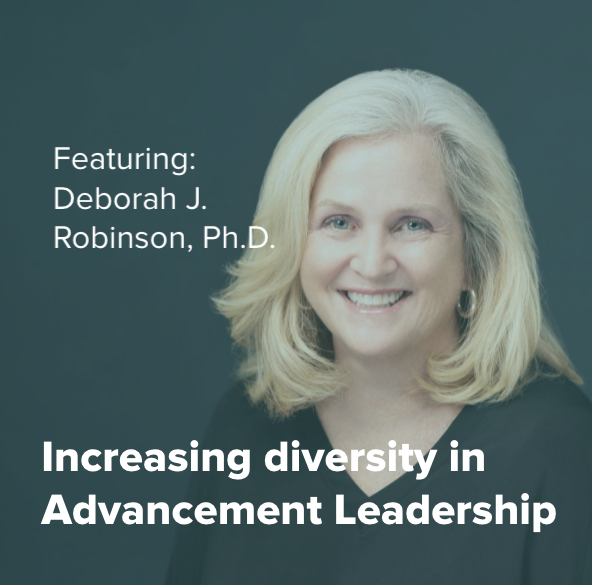Despite valiant efforts in the past 25 years to support women and leaders of color, a sample of the top advancement leaders reflects the painful truth: not much has changed. Today’s top advancement leaders in the largest and most successful fundraising programs are more than 60% white and male.
We cheer for all those that have made it to these positions, and know that they are highly skilled, deeply committed to being great leaders, and have persevered to the top jobs. However, while we have made some progress on advancing women in leadership roles, we have made almost no progress in advancing leaders of color to the highest paying, and most coveted positions in higher education advancement.
I hear every day from colleagues about their frustration on how to diversify the leadership in our industry, how experienced women are routinely passed over for younger, less experienced male candidates, and trying to find experienced, diverse candidates is frustrating at best. We, as a profession, are long overdue for a serious and honest discussion about the role our cultures, hiring practices, and talent recruitment efforts play in perpetuating the status quo. That is the bad news.
The good news is we can do something about it. It will not take a massive bureaucratic policy change, or a one-off strategic plan to yield real results. However, it will take focus, intentionality, prioritizing potential over experience, and elevating the standards of leadership.
Increase the number of women and minorities in your finalist pools.
In 2016, it was found that if there is only one woman in your pool of candidates – there is statistically zero (0%) chance she will be hired. The same holds true for minority candidates. “The odds of hiring a woman were 79.14 times greater if there were at least two women in the finalist pool (controlling for the number of other men and women finalists). …The odds of hiring a minority were 193.72 times greater if there were at least two minority candidates in the finalist pool (controlling for the number of other minority and white finalists).” (Johnson, Hekman, & Chan, 2016).
We have all heard the excuse that “there aren’t enough diverse leaders out there to attract.” If you are still doing your talent recruitment that way you have always done it – how could you expect to get a different result?
Get talent recruitment out of HR.
When I was responsible for sourcing and recruiting major gift officers as part of my role in advancement, it was easy to find high potential women and diverse candidates to join our team. I prioritized potential over experience.
Much like the “shiny bauble” or latest and greatest business idea, we need to distinguish potential from experience in our talent pools. The pandemic has changed the hiring dynamic for employees. It used to be that the employer held the power and control of when and where we worked. Not anymore…that dynamic has shifted. Changing your focus and processes to identify potential leaders will be critical to having the right individuals wanting to work for you, when you need them, and when they are ready to make a move. Identifying, qualifying, engaging, and cultivating a relationship with talent prospects – for the critical positions you need to fill in the next 1-3 years, will make all the difference in how successful your team will be.
The very best candidates are not out in LinkedIn world with their resumes. They are happy and busy doing their work. Just as we cultivate and engage prospective donors, we need to cultivate and engage the best and most diverse talent, before we need them. The responsibility for finding and nurturing diverse, high potential leaders should not be part of your human resources function. They are already super busy with internal processes, policies, and other bureaucratic stuff. Talent identification, cultivation and recruitment requires a different set of skills and focus.
Elevate the overall standards for leaders.
The current standard for leaders is depressingly low. Every day, we read about a leader who has cheated, lied, plagiarized, bullied, harassed, or in some way violated the trust given to them as leaders. That is just the list from this week’s newsfeed!
Leadership begins with us. Research has found that the most effective CEOs were not charismatic but were remarkably persistent and humble. They excelled not at self-promotion but at nurturing talent in their teams…these effective leaders worked to make other people shine and work together as a high-performing team. (Chamorro-Premuzic, 2019).
We should begin by finding or building leadership development programs for current and future leaders that focus on leading with humility, building trust and bridges, and creating a culture that values diversity of all kinds.
All the ideas here are great, but you must be willing to look in the mirror, be honest about where you are as an organization, team, or individual. Holding each other and yourself accountable for modeling the values, creating the next generation of effective leaders, and looking far and wide for the best potential talent is how we will make the change we seek to make for our beloved profession.
Sources:
Chamorro-Premuzic, T. (2019). Why Do So Many Incompetent Men Become Leaders? (and how to fix i)t. Harvard Business Review.
Stephanie K. Johnson, D. R. Heckman, and Elsa T. Chan (2016, April 16). If there’s Only One Woman in Your Candidate Pool, There’s Statistically No Chance She’ll be Hired. Harvard Business Review.
About the Author:

Dr. Deborah “Dee” Robinson founded C&D Associates in 2020 to develop The T.R.U.E.™ Leadership Path Project to provide training in becoming a T.R.U.E. Leader (www.robinsonleaders.com). An online course and private network of women leaders, the program is designed to meet the need for focused training, specifically for women, to support their success in becoming strategic and ethical leaders. T.R.U.E. Leaders create innovative and creative cultures, attract, and retain diverse and high performing talent, in values-based cultures.
Prior to founding C&D Associates, Dr. Robinson served as VP for Development at the University of Cincinnati Foundation, where her team raised over $1.2B in support of the University’s priorities. Dr. Robinson began her career at the Geisel School of Medicine at Dartmouth College and has led programs at Radford University, Florida Atlantic University and Vermont Law School. She holds a Ph.D. and Masters in Higher Education Leadership – Strategic Leadership from Florida Atlantic University. Her work and research focus on strategic leadership in the field of higher education, specifically in effective strategic planning, leadership, and change management.

Thank you for writing this insightful article and for being a champion in this profession. You are and continue to be an inspiring leader. Tony